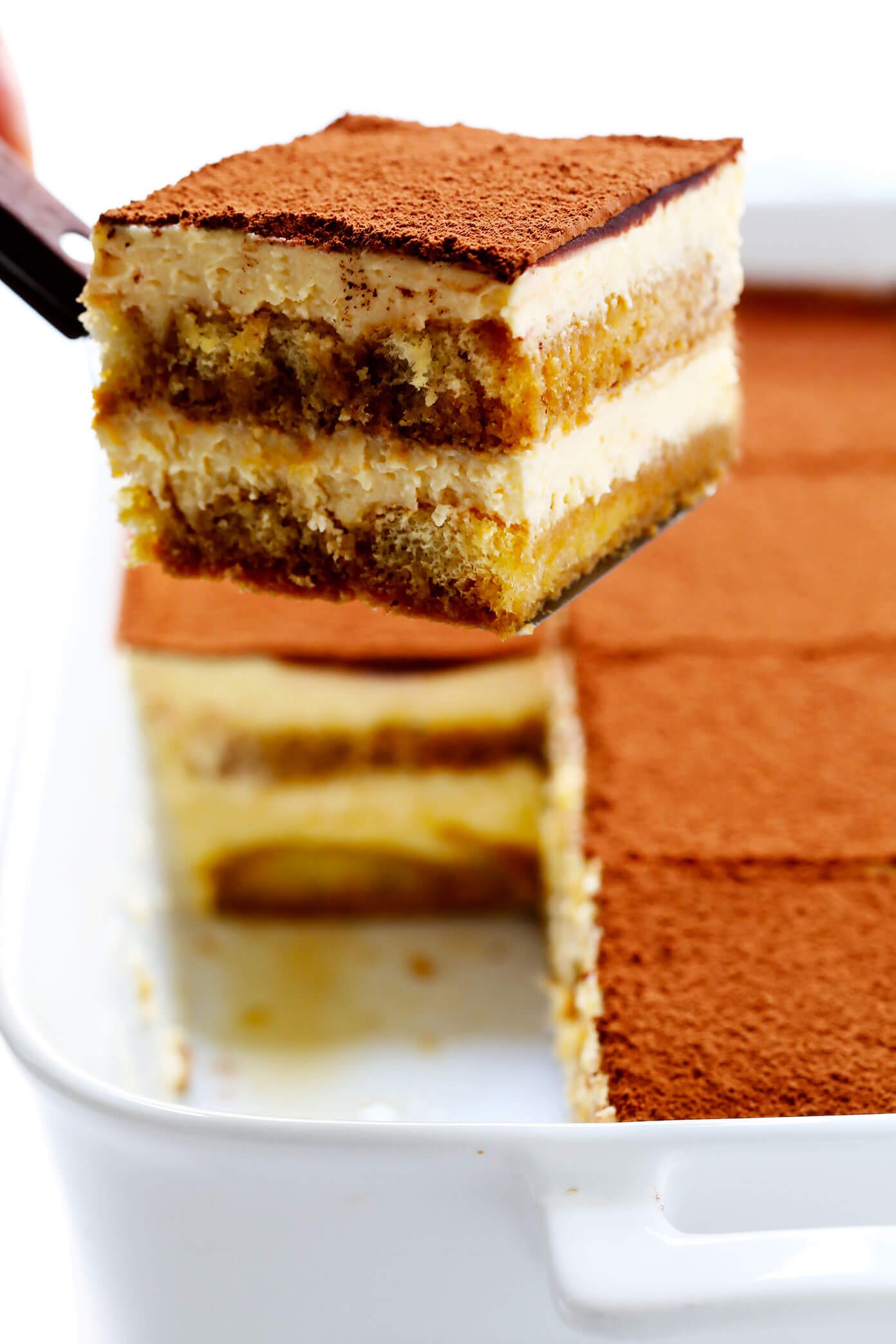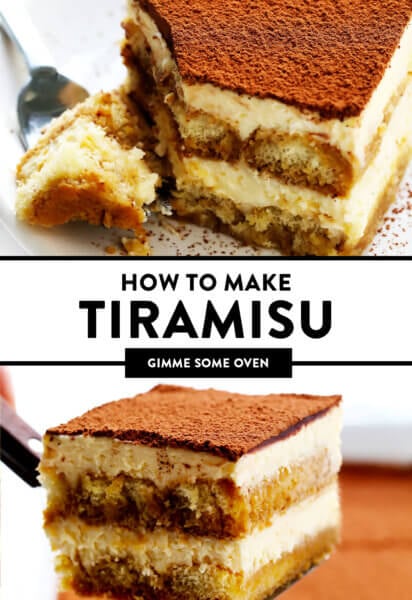This post may contain affiliate links. Please read my disclosure policy.
This Italian tiramisù recipe is easy to whip up, this version is made with cooked (instead of raw) eggs, and it tastes just as indulgent and delicious as ever.

My husband loves tiramisù.
I mean, let’s be honest, he and I are obsessed with basically all Italian food. But anytime we’re eating out at our favorite Italian restaurant and have feasted on antipasti, salads and pasta galore, I can’t help but laugh because Barclay still can never resist ordering a slice of tiramisù for dessert. Lol, I am always completely stuffed by that point and can’t even fathom the idea of additional carbohydrates. But when it comes to tiramisù, my sweets-loving husband insists “you can always make room.” ♡
Well, after missing our favorite Italian restaurant (and a trip we had planned to Italy) these past few months during all of the craziness of 2020, I decided to surprise Barclay by studying up on how to make tiramisù here at home. And I was pleased to discover that it’s actually much easier than I had expected! Plus, the bonus of making homemade tiramisu is that you have the option to (a) use decaf instead of caffeinated espresso, which I very much appreciate in the evenings (b) choose whether to use marsala, rum, brandy, bourbon, or you can omit the alcohol entirely, and (c) choose to use cooked instead of raw eggs. And of course, eat leftovers for breakfast the next day, which I very highly recommend.
So if you’re looking for an easy make-ahead Italian dessert this time of year that’s going to be a guaranteed crowd pleaser, pick up a package of ladyfingers the next time you’re at the store and let’s make some tiramisù!

Tiramisù Ingredients:
Alright, before we get to the full recipe (listed at the bottom of this post), let’s chat briefly about the ingredients you will need to make this tiramisù recipe.
- Egg yolks: Which will be cooked and whisked together with the granulated sugar and dry marsala (if using) to form the zabaglione (cooked egg custard).
- Granulated sugar: Just your usual basic white granulated sugar.
- Dry marsala: I love the flavor of dry marsala in tiramisù. But you are welcome to sub in rum, brandy, cognac, bourbon or any other liqueur that you prefer. Or, you are welcome to omit the alcohol entirely.
- Mascarpone: This creamy sweet cheese is the starring ingredient in our filling! Just be sure to drain off any excess water from the block of mascarpone before adding it to the recipe.
- Vanilla extract: To add a touch of vanilla flavor to the filling.
- Fine sea salt: To bring out all of those delicious flavors in the filling.
- Heavy cream: Which we will whip until it forms stiff peaks. (Basically, if you lift up a spoonful, the “peak” of cream on top should stay firm and not droop over.)
- Espresso: You can either brew your own espresso, whisk together hot water with espresso powder, or brew a very strong cup of coffee here. (Feel free to use decaf if you prefer.)
- Ladyfingers: You will need one (14-ounce) package of crisp ladyfingers for this recipe. When purchasing ladyfingers, be sure to avoid the varieties that are soft and spongy. You want the crisp and crunchy ladyfingers for this recipe, so that they do not fall apart once dipped in the espresso.
- Unsweetened cocoa powder: I like to add a layer of cocoa powder to the tiramisu while it is in the baking dish, and then also lightly dust each serving piece/plate just before serving.

How To Make Tiramisu:
Traditionally, tiramisù is usually made with raw eggs, which are separated into whites and yolks and whisked to form different components of the creamy filling. But for those who may also prefer not to eat raw eggs, I have written this tiramisu recipe with the alternative Italian method of using a zabaglione (cooked egg custard) in place of the raw yolks, and whipped cream in place of the raw whites. It sounds fancy but is easy to make, and I promise you won’t miss the raw eggs and it will still taste fabulous.
Heads up that this recipe does involve a number of mixing bowls and some patience with mixing various parts of the filling. Full directions are included in the recipe below, but here is a brief overview including a few important tips:
- Make the zabaglione. If you have a double-boiler, you can use that for this step. But I don’t, so I just heat an inch of water in a saucepan until it is simmering and then place a metal (or heat-safe glass) bowl on top of the saucepan. Combine the egg yolks, sugar and 1/4 cup (not all!) of the dry marsala in the bowl. Then use a whisk (or it’s easier to use a hand mixer on low speed) and whisk the mixture constantly for 5 to 7 minutes until it has turned a pale yellow color and nearly tripled in volume. It’s a bit of an arm workout if you do this by hand, but this step will cook the eggs and form a delicious custard that will serve as the base of our filling. Transfer the bowl to the fridge so that the mixture can cool slightly while you do the next two steps.
- Whisk the mascarpone mixture. Combine the mascarpone, vanilla extract and sea salt in a large mixing bowl and use a hand mixer (or a stand mixer) to beat briefly until smooth. Transfer mascarpone mixture to a clean bowl and set aside.
- Whip the cream. Add the heavy cream to the same large mixing bowl and beat using a handheld mixer (or stand mixer) on medium-high speed until stiff peaks form. (Basically, beat until the texture looks like thick whipped cream!)
- Combine the filling. Use a rubber spatula to gently fold the mascarpone mixture into the whipped cream until it is mostly combined, then gradually fold in the zabaglione mixture until combined. It’s important to avoid over-mixing here, otherwise the mixture will deflate.
- Make the espresso mixture. Stir together the espresso and remaining 1/4 cup of marsala in a small bowl.
- Assemble the tiramisu. Then one at a time, very briefly (just for a second!) dip the ladyfingers into the espresso so that both sides are coated, then arrange the lady fingers in an even layer covering the bottom of a 9×13-inch baking dish. Once the layer is complete, use a spoon (or an offset spatula) to spread half of the creamy filling mixture evenly on top of the ladyfingers. Repeat with a second layer of the espresso-dipped ladyfingers, followed by a second layer of the creamy filling.
- Chill. Cover and refrigerate the tiramisù for at least 4 to 6 hours, or until completely chilled.
- Serve. Use a fine-mesh strainer to dust the top of the tiramisù evenly with a layer of cocoa powder. Then slice, serve and enjoy!

Possible Variations:
Here are a few extra options to customize this tiramisù recipe to your liking…
- Use a different liqueur: As mentioned above, feel free to use rum, brandy, cognac, bourbon or any other liqueur that you prefer in place of the dry marsala.
- Omit the alcohol: If you would like to make this dish alcohol-free, no prob, just omit the alcohol altogether. It will still be delicious!
- Make it gluten-free: Use gluten-free ladyfingers to make gluten-free tiramisu.
- Pipe or swirl the top layer of filling (or add extra whipped cream on top): If you would like to make the top of your tiramisu look a bit more decorative, feel free to use a piping bag and your favorite tip to pipe on the top layer of filling. Or you can also use a spoon to swirl it around and make a pretty pattern. (Alternately, you can also pipe or swirl a layer of extra whipped cream on top.)
- Add chocolate shavings on top: In place of cocoa powder, we have been served tiramisu at some restaurants that has been sprinkled with finely-shaved dark chocolate which is also a lovely option.

Tiramisù FAQ:
What does tiramisù mean? Tiramisù translates in Italian to mean “pick me up” or “cheer me up” — which seems just right. 😉
Where did tiramisù originate? We have Italy to thank for this amazing dessert. And interestingly, while many believe it to be an centuries-old tradition, tiramisu is said to have been created fairly recently in the 1960s or 1970s.
Can you freeze tiramisu? Yes, just wrap it tightly in plastic wrap and freeze for up to 3 months. Then let the tiramisu thaw gradually in the fridge before serving.
Can you serve tiramisu immediately? Sure, but it will not slice well until it has been completely chilled. So you may need to eat it with a spoon if you absolutely cannot wait.

Description
This classic Italian tiramisù recipe is easy to make, it’s made with cooked (instead of raw) eggs, and it’s just as indulgent and delicious as ever.
Scale
Ingredients
- 8 large egg yolks
- 2/3 cup granulated sugar
- 1/2 cup dry marsala*, divided
- 1 pound (16 ounces) mascarpone cheese
- 1 teaspoon vanilla extract
- 1/4 teaspoon fine sea salt
- 1 1/2 cups heavy cream
- 1 1/2 cups espresso (or very strong coffee*)
- 36 to 42 crisp Italian ladyfingers (one 14-ounce package*)
- unsweetened cocoa powder
Instructions
- Make the zabaglione. Heat 1 inch of water in a large saucepan over medium heat until simmering. Combine the egg yolks, sugar and 1/4 cup of the dry marsala in a metal (or heat-proof glass) mixing bowl, and set it atop the saucepan. Using a whisk (or a hand mixer on low speed), whisk the mixture constantly for 5 to 7 minutes until it has turned a pale yellow color and nearly tripled in volume. Remove from heat and transfer the mixture to the refrigerator briefly to cool while you continue on with Steps 2 and 3.
- Whisk the mascarpone mixture. Combine the mascarpone, vanilla extract and sea salt in a large mixing bowl. Use a hand mixer (or a stand mixer) to beat the mixture on medium speed for 1 minute or until smooth. Transfer mascarpone mixture to a clean bowl and set aside.
- Whip the cream. Add the heavy cream to the same large mixing bowl and beat using a handheld mixer (or stand mixer) on medium-high speed until stiff peaks form.
- Combine the filling. Use a rubber spatula to gently fold the mascarpone mixture into the whipped cream until it is mostly combined. Then gradually fold in the zabaglione mixture until combined. Set aside.
- Make the espresso mixture. Stir together the espresso and remaining 1/4 cup of marsala in a small bowl.
- Assemble the tiramisu. One at a time, dip the ladyfingers (very quickly!) into the espresso so that both sides are coated, then arrange the lady fingers in an even layer covering the bottom of a 9×13-inch baking dish. Once the layer is complete, use a spoon (or an offset spatula) to spread half of the creamy filling mixture evenly on top of the ladyfingers. Repeat with a second layer of the espresso-dipped ladyfingers, followed by a second layer of the creamy filling.
- Chill. Cover and refrigerate the tiramisù for at least 4 to 6 hours, or until chilled.
- Serve. Use a fine-mesh strainer to dust the top of the tiramisù evenly with a layer of cocoa powder. Then slice, serve and enjoy! Leftovers can be covered and refrigerated for up to 3 days.
Notes
Total time: The total (prep) time listed in the recipe above does not include 4 hours of chill time.
Alcohol options: Feel free to use rum, cognac, brandy, kahlua, or any other liqueur you prefer in place of the dry marsala. Or, you can omit the alcohol entirely.
Espresso options: You can either brew your own espresso, brew a very strong batch of coffee, or add water to espresso powder for this recipe. Feel free to use decaf if you prefer.
Number of ladyfingers: The exact number of ladyfingers that you need will depend on the size/shape of your pan. Basically, just try to fit as many as you can into a single layer. It’s ok if there are some small gaps, but you can also break some of the ladyfingers in half if needed to fill in any big gaps.
Gluten-free option: Use gluten-free ladyfingers.




